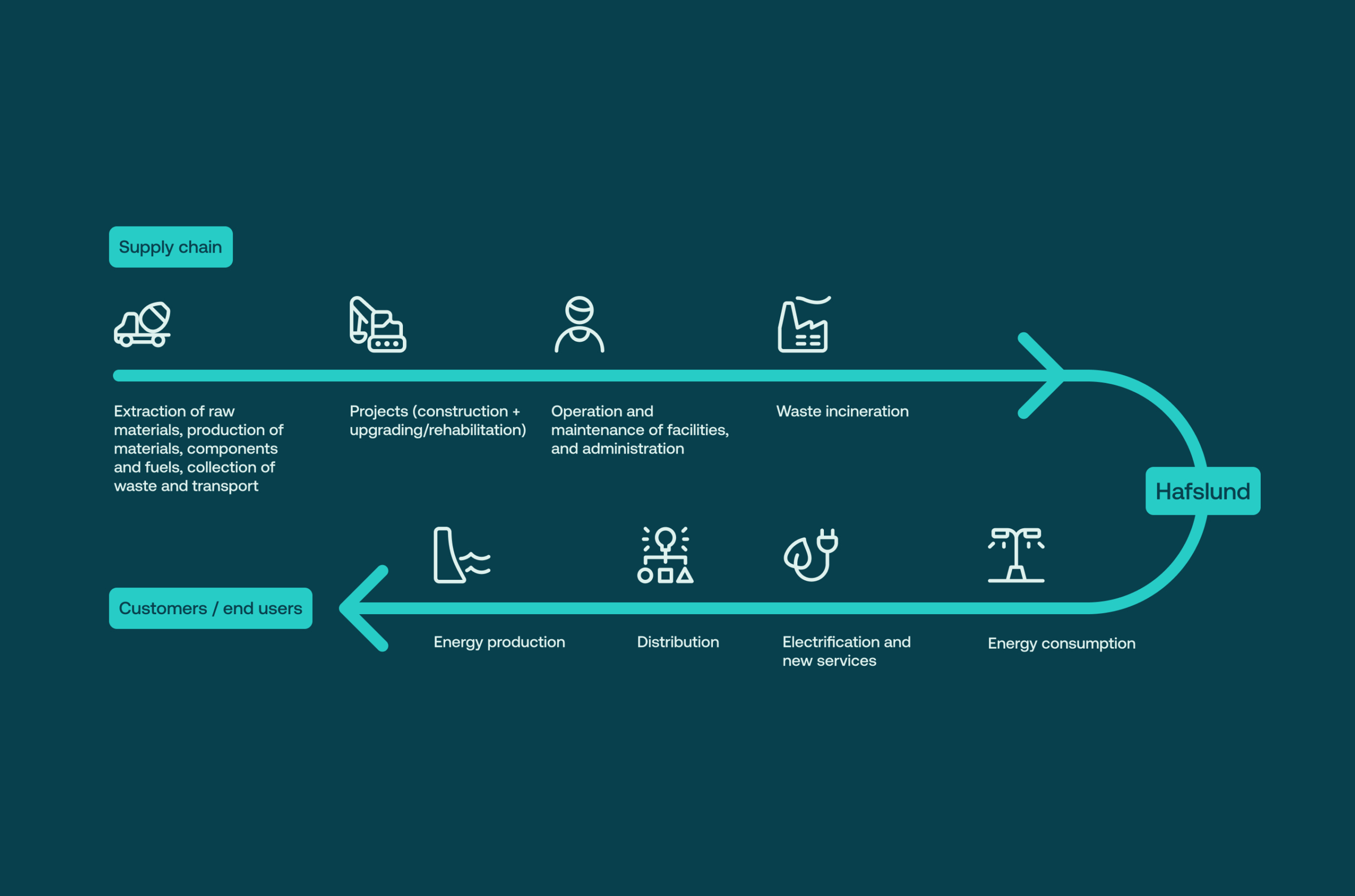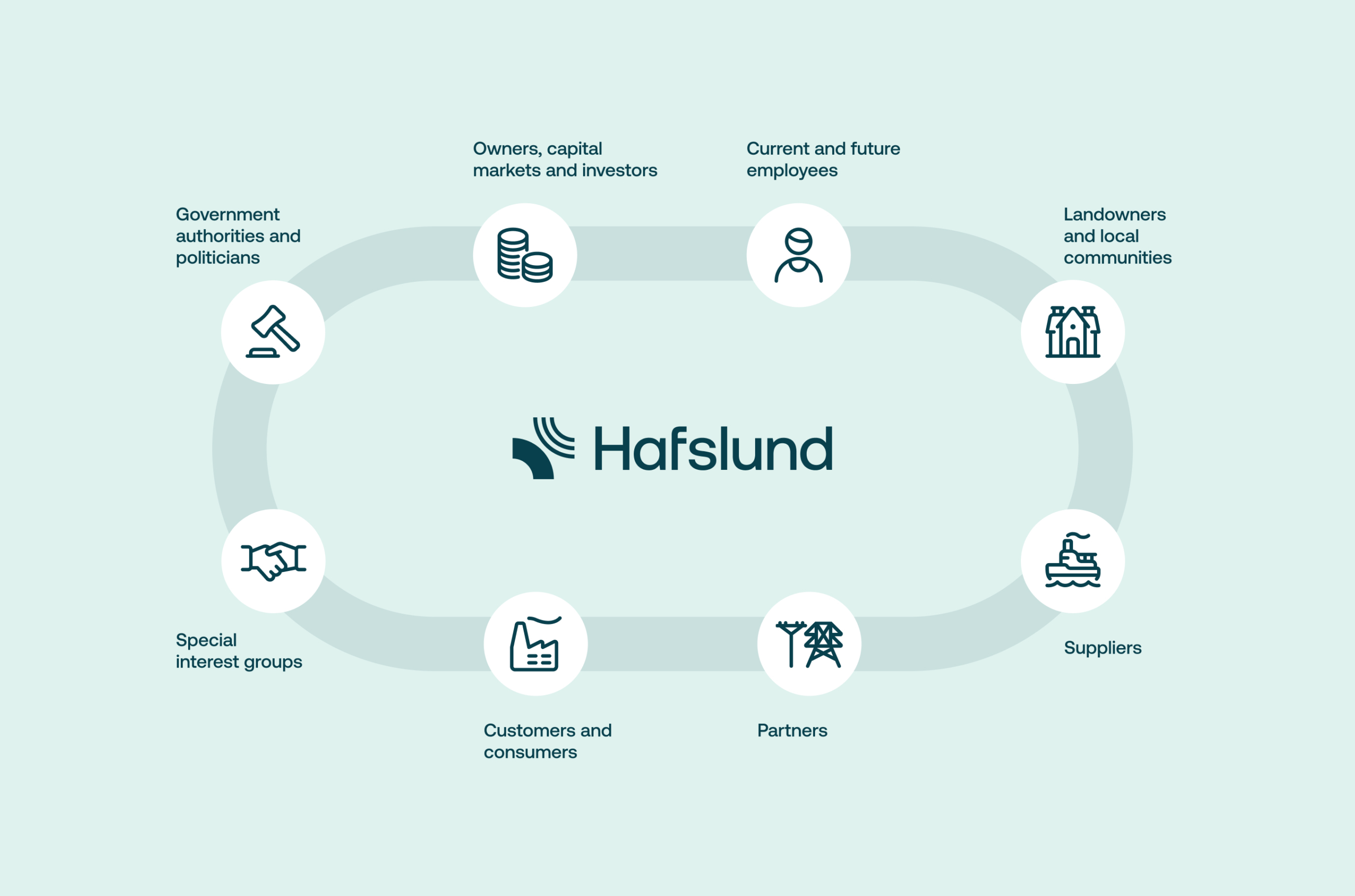
Sustainability at Hafslund
Material impact, risks and opportunities
Hafslund’s business strategy is closely linked to how the Group works with sustainability. The transition from fossil energy to renewable energy is definitively one of the most important measures for slowing global warming. Hafslund wants to prevent the negative impact on the climate by developing more renewable power. The Group will do this in such a way that the Group’s activities capture more carbon than they emit and that the Group’s positive impact on biodiversity compensates for the areas of land required for developing more renewable energy. To achieve this, Hafslund is reliant on good people with extensive knowledge and expertise relating to the topics that fall under the category of “Social conditions”. As a responsible stakeholder and owner of critical infrastructure, the Group must manage its activities in a professional manner. This means having good safety and emergency preparedness procedures, as well as conducting activities in a manner that is ethical and fair.
The topics that are important to Hafslund are shown in the table below:
Based on the materiality analysis, these are the topics for which Hafslund:
- Has a significant negative and/or positive impact on people and the environment; and/or
- Has identified significant risks and/or opportunities related to the impact of people and the environment on Hafslund.
The sustainability part of the annual report is structured according to the important topics. Identified impact, risks and opportunities are described in the chapters for each respective topic.
The basis for Hafslund’s important topics
| Environment | Social conditions | Governance |
|---|---|---|
| Climate change | Health and safety | Ethical business operations |
| Biodiversity and ecosystems | Expertise and culture | Emergency preparedness and cybersecurity |
| Resource use and circular economy | Human rights | |
| Contribution to society and local value creation |
Management of Hafslund’s impact, risks and opportunities
The basis for Hafslund’s important topic of sustainability is a double-materiality analysis that was conducted in autumn 2022. Hafslund’s materiality analysis was updated during the first half of 2023 and was based on the analysis from 2022. The new version in 2023 was simplified by combining some of the important topics that were identified in 2022. The designations and content that the updated topics now have are in accordance with the requirements stipulated in the EU Corporate Sustainability Reporting Directive (CSRD), which Hafslund will be obligated to comply with from and including the 2024 report. This makes it easier for users of sustainability reporting to read and understand Hafslund’s sustainability work, as well as simplifying the comparison of content with sustainability reporting from other companies. The updated important topics were adopted by Group management in May 2023.
A new materiality analysis is being conducted during the first quarter of 2024 that takes into account the requirements in the CSRD and the recommendations of the European Financial Reporting Advisory Group (EFRAG).
The impact analysis
The impact analysis was a desktop analysis where a list of potential topics of importance to sustainability was compiled based on available advisory literature and established practices from comparable companies. A value chain analysis was then conducted, whereby the impact of each topic was assessed based on three criteria: size, severity and irreversibility. Based on this, for each part of the value chain we considered whether there is a small, medium or large impact and whether the impact is positive, negative or both positive and negative.
The risk analysis
The risk analysis was based on two streams of information obtained through a stakeholder analysis and a megatrend analysis. The purpose was to identify how the outside world (people and the environment) impact Hafslund, and what risks and opportunities this poses for the Group. An assessment was carried out of what Hafslund’s stakeholders currently expect (stakeholder analysis) and what major drivers (megatrends) determine what stakeholders will care about in the future.

Several of the Group’s high-priority risks are closely linked to the material sustainability topics and the most important sustainability risks are followed up by the Group’s risk management function in the same manner as the other top risks.
The materiality analysis is the starting point for how Hafslund manages the work on sustainability in the Group. Goals, measures, action plans and KPIs shall be defined for each important topic. Hafslund has established good goals, measures, plans and KPIs for some topics, while this work is still ongoing for other topics.
Several of the Group’s high-priority risks are closely linked to the material sustainability topics and the most important sustainability risks are followed up by the Group’s risk management function in the same manner as the other top risks. The work on incorporating risks and opportunities for all important topics started in 2023 and will be expanded during 2024. This is already well integrated for several of the important topics, and the impact, risks and opportunities are followed up on an ongoing basis. This particularly applies to the important topics of “Health and safety” and “Emergency preparedness and cybersecurity”.
In 2023, a climate risk analysis was conducted in accordance with the Task Force on Climate Related Financial Disclosures (TCFD) framework. The results of the analysis are described in the chapter covering the important topic of “Climate change”. Some of the defined risks in the climate risk analysis are part of the Group’s top risks. The risks that are not top risks for the Group but are the most important climate risks are incorporated into the Group’s risk management system.
Risks of violations of human rights and decent working conditions are other topics that were actively addressed during 2023 through the work on the Transparency Act. This work will be further developed in 2024. Reference is made to the chapter entitled “Human rights”.
Sustainability management (Governance)
The roles of the Board, the Risk and Audit Committee and management
In Hafslund, sustainability is integrated into the business strategy and is high on the agenda of group management, the Risk and Audit Committee and the Board. When CSRD is introduced in Norwegian law, the Risk and Audit Committee will be given responsibility for sustainability reporting on the same level as financial reporting. Hafslund has serious ambitions related to climate and nature. In connection with this, “Deep dive into climate” and “Deep dive into nature” were two issues that were addressed in 2023. In addition, the updating of the materiality analysis and important topics, updating of the Group sustainability policy, work on and report for the Transparency Act, dilemma training related to human rights, climate risk and risk management, information about the Corporate Sustainability Reporting Directive (CSRD) and the implementation project of the CSRD and involvement in the annual reporting were considered by the Group management team and Board. Health and Safety (HSE) is at the top of the agenda of all management groups. In addition, diversity, tax and local impact, emergency preparedness, and safety, was among the topics that management was involved in throughout the year.
The Head of Sustainability at Hafslund reports to the Executive Vice President Corporate Development and is responsible for proposing content to be included in the Group’s goals and procedures, and for assisting the business areas in establishing measures to comply with goals and guidelines. The Head of Sustainability is also responsible for formulating the Group’s sustainability reporting.
Hafslund’s Group sustainability policy is prepared based on the materiality analysis. General information about the policy is described in the “Policy/Guidelines” section of this chapter and relevant information for each important topic is described in the corresponding chapter. There are also a number of other governing documents that are relevant to sustainability, such as the HSE policy, ethical guidelines for employees and ethical guidelines and requirements for suppliers. More information concerning this can be found in the chapter on the relevant important topic. In 2023, Hafslund commenced major work on updating governing documents adapted to the Group’s size and new requirements and expectations that these include guidelines related to the Group’s important topic of sustainability.

Risk management and internal control
Sustainability is a natural part of the Group’s risk management, and several of the Group’s high-priority risks, both operational and strategic, are risks related to the climate and nature crisis or the transition to a fair, net zero-emission society. More information about the Group’s risk management is described in the Board’s annual report and the consolidated accounts. For sustainability specifically, Hafslund has reported significant risks and opportunities associated with each important sustainability topic.
Reporting of sustainability-related information has historically not been subject to the same internal control requirements as financial reporting. In 2023, Hafslund intensified cooperation between different specialist fields in the Group, including the sustainability department, the risk function and the finance department. This was to ensure more consistent content, structure and internal control when reporting qualitative and quantitative sustainability information. Among other things, Hafslund has begun work on improving quality when reporting sustainability information and utilises expertise, experience and processes from financial reporting where appropriate.
Sustainability in Hafslund’s strategy
Business strategy, business model and value chain
The link between the Group’s business strategy up to 2035 and Hafslund’s significant impact, risks and opportunities is described in the chapters for each respective important sustainability topic.
Below is a simplified illustration of Hafslund’s value chain:

Hafslund’s key stakeholders
Eight key stakeholders have been identified that have different requirements for and expectations of Hafslund. The stakeholder analysis identified stakeholder expectations with subsequent risks and opportunities. The insight into the stakeholder expectations was used as an insight and basis for the materiality analysis.

Moving forward, Hafslund plans to implement a system to document and follow up on stakeholder dialogue.
Government authorities and politicians
Government authorities and politicians set framework conditions for the Group’s business activities. Hafslund meets this stakeholder group with knowledge and information and has a desire to provide insight into the consequences of different framework conditions for the management of and investments in renewable energy.
Government authorities are concerned about a wide range of sustainability topics, with a particular focus on the production and distribution of sustainable energy, waste incineration, security of supply and competitive prices.
From a national and international perspective, there are expectations related to climate adaptation and reducing greenhouse gas emissions, as well as protecting natural diversity and minimal destruction of ecosystems. To ensure that Hafslund, and other companies, are meeting these expectations, there is an increasingly strong need for transparency and reporting.
Owners, capital markets and investors
Hafslund has a good relationship with the Group’s only owner, the City of Oslo, which sets clear expectations regarding several sustainability areas through, among other things, the Oslo Model and the ownership report. Hafslund works together with the City of Oslo on issues such as sustainability and urban development. Several of the Group’s companies have other owners in addition to the parent company Hafslund AS, which are also committed to and have expectations for responsible and sustainable operations.
The owner’s goal is to have predictable dividends over time. In addition, the owner has a focus on the Group actively contributing to solving the climate and nature crisis as a producer and distributor of clean energy. Loan investors and the capital market are increasingly concerned about sustainability. With ever stronger demands and expectations, transparency and good reporting are an important expectation from the owner, capital market and investors. In 2023, Hafslund updated its green financing framework to include the business activities of all the subsidiaries. The framework is based on relevant market standards, and the majority of the Group’s financing qualifies as “green”.
Owners of Hafslund and Hafslund’s subsidiaries are focussed on local value creation, local jobs and revenues from dividends and taxes. The City of Oslo is also concerned about responsible procurement practices and that Hafslund contributes to the City of Oslo achieving its climate targets.
Current and future employees
Our employees are Hafslund’s most important resource that will enable the Group to succeed with its vision and objectives. The Group’s employees want a meaningful and rewarding workplace in a safe and responsible company that has sustainability on the agenda. Health, safety and the work environment is another important area, together with scope for employees to develop their own expertise. Both current and future employees are increasingly placing diversity and equality higher on the agenda of priorities.
Hafslund works continuously to have a visible and supportive management that maintains good dialogue across the entire Group. The Group works for a culture that is based on the Group’s values and the manitenance of an open and inclusive working environment. More information about the dialogue with Hafslund’s employees can be found in the chapters “Expertise and culture” and “Health and safety”.
Landowners and local communities
With facilities and infrastructure that require significant land use, good dialogue with landowners and local communities is of vital importance to Hafslund. Hafslund maintains a close dialogue with this special interest group, particularly in connection with developments and upgrades of existing facilities. It is of particular importance to landowners and communities that the Group contributes to local value creation and jobs.
There is an expectation of responsible operations, conservation of nature, recreational opportunities, minimal pollution and adequate flood protection. Transparency and early involvement through good stakeholder dialogue are important for Hafslund.
Special interest groups
Special interest groups not only have an increasingly powerful voice in local communities but also politically, and have clear expectations around protecting public interests, minimizing destruction of nature and ecosystems, recreation and reducing greenhouse gas emissions.
Hafslund has dialogue with various special interest organisations: fishing interests, nature and environmental organisations, welfare associations, landowner groups, tourist associations and others. The Group seeks to collaborate and conduct dialogue in order to exchange information about advantages and disadvantages relating to the business activities and to facilitate learning across the various stakeholders.
Customers and consumers
Hafslund shall ensure the reliable supply of energy and other products and services for end users and commercial customers. Hafslund looks to understand customer needs and to meet their expectations. Customers and consumers depend on energy from Hafslund and are concerned about fair prices and security of supply. Consumers are also increasingly focused on user-friendly solutions, and that the energy they purchase is sustainable and originates from producers who manage their impact on people and the environment in a responsible manner. Hafslund has dialogue with both current and potential customers, and regularly follows up reputational surveys.
Partners
Hafslund has several partnerships and has a policy of seeking partnerships where complementary expertise and collaboration can result in stronger value creation.
The Group’s partners expect adaptation to and reduction of negative climate change. Many view collaboration with Hafslund as a good opportunity for development and expect the Group to strive for innovation and the development of green solutions. There is an expectation that Hafslund has a high level of expertise and also shares this expertise. Partners also expect the Group to have the resources and impetus to see initiatives through to the end.
Suppliers
With regard to suppliers, Hafslund engages in dialogue that is specifically related to HSE, sustainability and supply/security of supply, and the Group endeavours to achieve best practice in such cooperation. Suppliers generally want to work with large, sustainable companies with good reputations, which can help the suppliers themselves to improve.
Fair price and equal treatment are the clearest expectations from Hafslund’s suppliers. They also request information about upcoming projects and future needs. High standards of business integrity, HSE, and human and worker rights are expected.
Metrics and targets
Efforts were made during 2023 to set metrics and targets related to each important topic. Many of the targets have been included for several years and some of the targets are new in this year’s reporting. Among other things, Hafslund has had metrics and targets related to greenhouse gas emissions since 2019, and these were further set in stone in 2022. For other topics, such as “Health and safety”, Hafslund has long had specific metrics and targets related to life and health.
Hafslund has high ambitions related to the Group’s impact on biodiversity and ecosystems. In 2022, it was defined and reported that Hafslund works for nature-positivity. In 2023, the Group actively worked to specify what this means for current operations and for new projects. More information about how Hafslund has worked and is continuing to work on setting metrics and targets and defining accurate indicators can be found in the chapter for the important topic of “Biodiversity and ecosystems”.
Policy/Guidelines
Hafslund has a Group policy for sustainability which ensures that the Group has uniform principles related to sustainability. An annually updated materiality analysis forms the basis for the Group’s sustainability work and the content of the policy. This policy has been adopted by the Group management team. It applies to all companies in the Group over which Hafslund has operational control through ownership and/or agreements. Each subsidiary is responsible for setting metrics and targets and action plans for sustainability in accordance with the principles in the policy.
Basis for preparing sustainability reporting
Sustainability reporting covers the Hafslund Group, and unless otherwise specified, the scope is the same as for the financial reporting for the 2023 calendar year. In sustainability reporting, data is collected from all businesses where Hafslund is the majority owner and has operational control, and these figures are included in their entirety in the sustainability accounts. Qualitative and descriptive text is based on the Hafslund Group as a whole, with the three business areas of Hydropower, District Heating and Cooling, and Growth and Investment.
In the materiality analysis, the entire value chain is used as a basis for the assessments that are made. For all of Hafslund’s important topics, there is a form of impact, risk or opportunity beyond the Group’s own business activities. For the quantitative reporting, Hafslund has defined the scope when this is not clear and obvious.
Hafslund is governed by the new EU Corporate Sustainability Reporting Directive (CSRD) and must report in accordance with these requirements in the 2024 annual report. Implementing the CSRD into the organisation is demanding work that impacts and affects large parts of the business. Hafslund has established a Group-wide implementation project. The success of this requires involvement across subsidiaries and business areas.
Hafslund’s Sustainability Report 2023 was inspired by the European Sustainability Reporting Standards (ESRS) from the European Financial Reporting Advisory Group (EFRAG) and the EU. Further conformity with these standards was achieved in this year’s report by:
- The sustainability information being structured according to environmental, social and corporate governance (ESG) considerations, and the reporting being centred around Governance (GOV), Strategy (SBM), Impact, risk and opportunity management (IRO) and Metrics and targets (MT).
- The important topics having wording and content that more closely resemble the terms used in the European Sustainability Reporting Standards (ESRS).
- The selection of indicators and data that Hafslund chooses to highlight being almost identical to the ESRS requirements.
The basis for calculations and use of estimates, as well as degree of uncertainty, are described in connection with the relevant indicator in the sustainability accounts when this is relevant and of significant importance.


